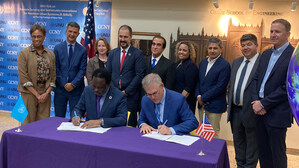Waste-to-Energy Plays Key Role in Reduction of Greenhouse Gases and Complements Recycling Efforts, Study Finds
New report from The City College of New York provides comprehensive scientific review of industry's technology as large-scale waste management solution
NEW YORK, May 25, 2021 /PRNewswire/ -- Waste-to-energy facilities offer significant environmental protection, reduce greenhouse gas emissions, and play an important complementary role in recycling efforts, according to a new City College of New York report that reviewed the most up-to-date scientific studies of the industry.
The report, "The Scientific Truth about Waste-to-Energy" by CCNY professor and chemical engineer Dr. Marco J. Castaldi, calls upon dozens of independent scientific reviews to offer a comprehensive assessment of waste-to-energy's influence on environmental sustainability and public health. The report was peer-reviewed by subject matter experts at Columbia University, University of Maryland, North Carolina State University, State University of New York- Stony Brook, and several international and U.S.-based energy and resource management officials.
The report can be used to address outdated data and unscientific conclusions that have fueled debate around the safety and benefits of waste-to-energy. By analyzing the findings of a wide range of independent research studies conducted around the globe, the report serves as an in-depth guide for policy makers and municipalities evaluating the scientific merits of waste-to-energy and its appropriate role in sustainable waste management initiatives.
"In recent years, it has become evident that local policy makers struggling to manage daunting waste management challenges are doing so with outdated or erroneous information," Castaldi said. "This report is an effort to provide officials with a single source of reliable information that draws its conclusions from a wide range of research and has undergone rigorous vetting by subject matter experts from diverse backgrounds and organizations. My hope is that, moving forward, officials will be well positioned to make policy decisions based on established facts rather than unsubstantiated claims."
The world currently has more trash than at any point in history – with the U.S. generating nearly 300 million tons a year, according to the most recent EPA figures. Waste-to-energy facilities generate renewable energy from non-recyclable and non-compostable waste that would otherwise be landfilled. Castaldi's report notes the amount of waste to be landfilled can be reduced up to 90% when employing waste-to-energy.
The report highlights key benefits of using waste-to-energy technology, including significant reductions in greenhouse gas (GHG) emissions, the industry's compatibility with recycling and strong correlation with increased recycling in the U.S., and a significant reduction in the vast U.S. land mass that is being consumed by landfills, which are a significant source of methane, a powerful GHG. It also includes peer-reviewed, scientific studies that show waste-to-energy facilities do not adversely affect human health and that the highly regulated conversion process has a negligible impact on air quality compared to emissions from trucking and other traffic-related air pollution.
The report comes at a critical time, with new federal commitments to reduce greenhouse gas emissions and a dawning realization of the limitations of relying only on reduce, reuse, and recycling programs. Additionally, the United Nations issued a report this month highlighting the importance of cutting methane emissions to slow global warming.
Independent research conducted around the world has established that modern emissions control technology and strict regulatory standards ensure the waste-to-energy conversion process is performed in a way that effectively safeguards public health and the environment, the report found.
"Until global manufacturing and packaging practices change dramatically, we will have to contend with significant amounts of unrecyclable waste. In the meantime, there are only two ways to manage the unrecycled waste our society produces: landfill it or use it to safely generate energy," said University of Maryland Professor Ashwani Gupta, a member of the peer-review panel. "Every credible study conducted on this subject has concluded converting waste to energy is preferable to landfilling."
The following expert sources, recognized internationally for their research and other scientific and engineering contributions, have reviewed the Castaldi report to ensure the information and data presented in the report are both accurate and current.
- Professor Nickolas Themelis, Columbia University
- Professor Ashwani Gupta, University of Maryland
- Professor Frank Roethel, State University of New York, Stony Brook
- Mr. Anthony Licata, ASME Fellow, Licata Energy & Environmental Consultants, Inc.
- Dr. Helmut Schnurer, former Deputy Director General, Ministry for Environment, Germany
- Dr. Michael Weltzin, Senior Scientific Advisor, Waste and Climate Policy, German Green Party
- Rene Moeller Rosendal, Danish Waste Solutions, ISWA Vice Chair Landfilling
- Dr. Richard Honour, Executive Director, The Precautionary Group
- Philipp Schmidt-Pathmann, Founder and Executive Director, IERM
SOURCE The City College of New York
WANT YOUR COMPANY'S NEWS FEATURED ON PRNEWSWIRE.COM?
Newsrooms &
Influencers
Digital Media
Outlets
Journalists
Opted In






Share this article